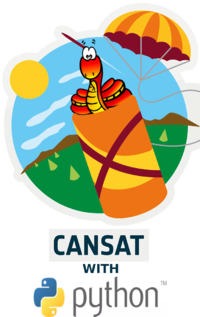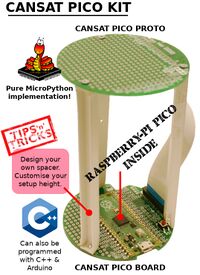ENG-CANSAT-PICO-BELGIUM
Cansat in Python
Thank to MicroPython, you can program your CanSat with Python.
Other solution CanSat Arduino with Feather M0
What is CanSat?
CanSat Contest simulates the fly of miniaturized satellites named CanSat (Can Satellite).
The CanSat is an autonomous devices enclosed within the volume of a soda can.
The volume of a CanSat has the following characteristics: 66mm diameter, 115mm height for a mass of 350gr.
As the CanSat have small volume and are very affordable, the CanSat contest is great for learning more about space technologies.
The CanSats are deployed from a rocket (the launch vehicle) at a height of about 3000m depending on the competition (see all the details in the contest rules).
The CanSats are not orbited and are always deployed in the athmosphere. So they always comes back to the earth.
The CanSat volume cannot increase until the CanSat is deployed out of the rocket.
This means that external antenna is allowed only after the CanSat left the rocket.
A parachute (that increase the volume of the CanSat) is usually used to limit damages. The aim is to reuse the CanSat for several missions.
In Europe, the CanSat contest includes two missions:
- Mission 1: mesure pressure and temperature and transmit data in real time.
- Mission 2: free choice mission (using Intertial Measurement Unit, GPS, MPX differential pressure sensor, etc).
Getting Started
Test the devices
Testing the communication with RFM69HCW and sending data through the radio module.
Mission 1
The team must build a CanSat and program it to accomplish the primary (mandatory) mission, as follows:
After release and during descent,
- the CanSat shall measure several parameters,
- the data should be transmitted as telemetry information to the ground station.
- the telemetry should, at least, be send once every second.
The following informations should be captured:
- Air temperature
- Air pressure
It must be possible for the team to analyse the data obtained (for example, make a calculation of altitude) and display it in graphs (for example, altitude vs. time and temperature vs. altitude).
Ressources
Optional: Adding a GPS module to transmit the CanSat position with the telemetry data would ease to positioning when back on the earth.
Other ressources:
- CanSat Europe on WikiPedia - Lot of informations
- This wiki as PDF (pdf)
- Raspberry-Pi Pico RP2040 Presentation (pdf)
- CanSat Kit Presentation v3 (Belgium) (pdf, nov 2023)
- CanSat Kit Presentation v1 (Belgium) (pdf)
How to subscribe the contest?
In Europe, the CanSat competition is promoted by the ESA (source).
- For Belgium: the CanSat Belgium competition is promoted by InnovIris (CanSat Belgium NL, CanSat Belgium FR, CANSAT Belgium FaceBook ).
Innoviris is the Brussels Institute for the encouragement of scientific research and innovation.
- For Luxembourg: the CanSat Luxembourg competition is promoted by Esero Luxembourg (www.cansat.lu) .
About this Wiki
MC Hobby does promote, mainly in French, the Arduino Open-Source plateform, MicroPython, Raspberry-Pi, coding, electronics to made knowledge freely available de the mass.
This CanSat Belgium Wiki is one of the MC Hobby documentation project.
Written by Meurisse D. for MCHobby

